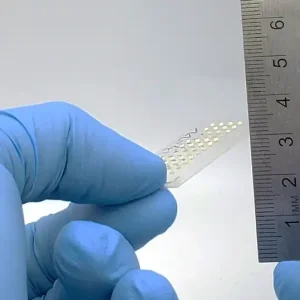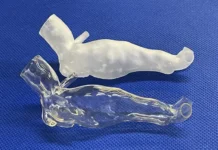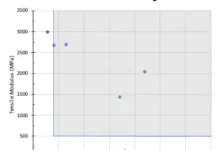By Jason P. Killgore, NIST Photopolymer Additive Manufacturing Project

The working curve is a foundational measurement in Vat Photopolymerization (VP) additive manufacturing methods, such as stereolithography (SLA), digital light processing (DLP) and masked SLA. The working curve establishes a relationship between the depth (or thickness) of a photo-cured resin and the corresponding dose of light that irradiated the measured feature. The light dose typically has units of mJ/cm2 and is determined from the product of light intensity (mW/cm2) and exposure duration (s). The working curve has proven exceedingly useful in determining process parameters for VP. For example, the working curve allows interpolation of the dose required to cure a layer of programmed thickness.
Under idealized conditions, the working curve is perfectly linear when plotted with a logarithmic dose axis and a linear depth axis. This log-linear dependence of cure depth on exposure dose is attributed to the Beer-Lambert absorption of light, which specifies that the intensity of light in a uniform absorbing medium decays exponentially with depth. The depth of light penetration is given by the slope of the working curve. As a first order approximation, achieving gelation of a resin will require a fixed number of photons at a given wavelength (i.e., dose), thus the cure depth intimately is related to the exposure dose. This critical dose for gelation Ec is determined from the x-intercept of the working curve.
Traditionally, the light dose would be measured by characterizing the light source with a power meter, and the feature thickness would be measured using some form of micrometer or caliper. More advanced thickness measurements, such as stylus or optical profilometry, also have been employed. Recently, novel methods of determining cure depth employed oscillatory photo-rheometry, interferometry and atomic force microscopy.
Despite the widespread use of the working curve and the recent advancements in the technology, standardization of the method has been notably lacking. In January 2023, the Photopolymer Additive Manufacturing Alliance and the National Institute of Standards and Technology kicked off a series of round-robin studies to bring standardization (either de facto or formal) to the working curve measurement. More than 20 stakeholders attended the kickoff meeting, representing resin formulators, instrument OEMs, government labs and academic institutions from multiple countries.
The phase I round-robin study asks participants to characterize a common batch of photopolymer resin (established as a NIST reference grade test material) using the participant’s “in-house” working curve method. NIST then will aggregate and present the results, and the community will come together to propose a standardized or best-practice measurement approach for phase II.
This is an exciting time for working curve practitioners as working curve results make their way onto product data sheets, internal quality control practices and printer calibrations. Beyond establishing a common language for working curve discussions (i.e., where lab A and company B reliably get the same results), the working curve round-robin study hopefully also will set the stage for a NIST reference resin with certified working curve behavior at specified wavelengths.
Jason P. Killgore is the NIST Photopolymer Additive Manufacturing Project co-leader and PAMA co-founder. For more information, email jason.killgore@boulder.nist.gov.







